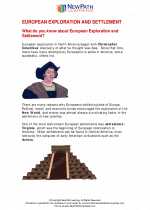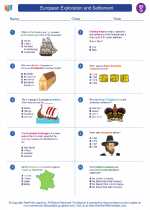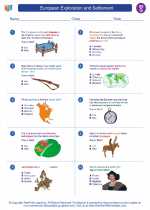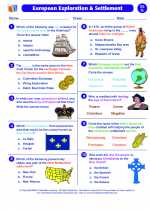European Exploration and Settlement
European exploration in North America began with Christopher Columbus’ discovery of what he thought was Asia. Since that time, there have many attempts by Europeans to settle in America, some successful, others not. There are many reasons why Europeans settled outside of Europe. Political, social, and economic forces encouraged the exploration of the New World, and money was almost always a motivating factor in the settlement of new colonies. Read More...
◂Social Studies Worksheets and Study Guides Seventh Grade. European Exploration and Settlement
Study Guide European Exploration and Settlement
European Exploration and Settlement  Worksheet/Answer key
Worksheet/Answer key European Exploration and Settlement
European Exploration and Settlement  Worksheet/Answer key
Worksheet/Answer key European Exploration and Settlement
European Exploration and Settlement  Worksheet/Answer key
Worksheet/Answer key European Exploration and Settlement
European Exploration and Settlement  Worksheet/Answer key
Worksheet/Answer key European Exploration and Settlement
European Exploration and Settlement 

 Worksheet/Answer key
Worksheet/Answer key
 Worksheet/Answer key
Worksheet/Answer key
 Worksheet/Answer key
Worksheet/Answer key
 Worksheet/Answer key
Worksheet/Answer key

The resources above cover the following skills:
National Curriculum Standards for Social Studies (NCSS)
TIME, CONTINUITY, AND CHANGE
SOCIAL STUDIES PROGRAMS SHOULD INCLUDE EXPERIENCES THAT PROVIDE FOR THE STUDY OF THE PAST AND ITS LEGACY.
KNOWLEDGE - Learners will understand:
The study of the past provides a representation of the history of communities, nations, and the world.
That learning about the past requires the interpretation of sources, and that using varied sources provides the potential for a more balanced interpretive record of the past.
That historical interpretations of the same event may differ on the basis of such factors as conflicting evidence from varied sources, national or cultural perspectives, and the point of view of the researcher.
Key historical periods and patterns of change within and across cultures (e.g., the rise and fall of ancient civilizations, the development of technology, the rise of modern nation-states, and the establishment and breakdown of colonial systems).
The contributions of key persons, groups, and events from the past and their influence on the present.
The influences of social, geographic, economic, and cultural factors an the history of local areas, states, nations, and the world.
National Center for History in Schools (NCHS)
Historical Thinking Standards
Chronological Thinking
Identify the temporal structure of a historical narrative or story.
Reconstruct patterns of historical succession and duration; explain historical continuity and change.
Historical Comprehension
Reconstruct the literal meaning of a historical passage.
Identify the central question(s) the historical narrative addresses.
Historical Analysis and Interpretation
Draw comparisons across eras and regions in order to define enduring issues.
Challenge arguments of historical inevitability.
Hold interpretations of history as tentative.
Historical Research Capabilities
Formulate historical questions.
Historical Issues-Analysis and Decision-Making
Identify issues and problems in the past.
Identify relevant historical antecedents.
United States History Content Standards
Era 1: Three Worlds Meet (Beginnings to 1620)
Comparative characteristics of societies in the Americas, Western Europe, and Western Africa that increasingly interacted after 1450.
The student understands the differences and similarities among Africans, Europeans, and Native Americans who converged in the western hemisphere after 1492.
Era 2: Colonization and Settlement (1585-1763)
How political, religious, and social institutions emerged in the English colonies.
The student understands social and cultural change in British America.
World History Content Standards
Era 4: Expanding Zones of Exchange and Encounter, 300-1000 CE
The search for political, social, and cultural redefinition in Europe, 500-1000 CE.
The student understands the coalescence of political and social order in Europe.
Era 6: The Emergence of the First Global Age, 1450-1770
Economic, political, and cultural interrelations among peoples of Africa, Europe, and the Americas, 1500-1750.
The student understands how states and peoples of European descent became dominant in the Americas between the 16th and 18th centuries.